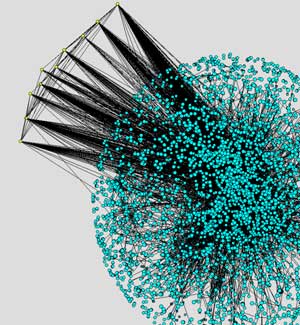The conversation might go something like this: “I would like to increase the trafficking of a protein to the plasma membrane in HEK cells. Should I add a signal sequence to import it into ER?”
Or it could go: “We’re back in New York and keen to meet local scientists or sci-comm folk. Good excuse for a NYCscitweetup, meet tonight at Klarney Rose.”
Both are from real blog entries posted to online scientific communities. And both may hold clues to the future of worldwide scientific advancement.
Bowdoin College Assistant Professor of Sociology Dhiraj Murthy is tracking posts like these as part of a major three-year study supported by the National Science Foundation’s Office of CyberInfrastructure. The goal is to collect and quantify data to help evaluate the potential of social networking site technology (SNS) to enhance scientific collaboration and innovation.
“If you’re a scientist who has an idea, how do you take it further? You can go through the traditional means of meeting other scientists through professional networks or local meetings, but you can also go online to interact with potential collaborators worldwide. My study will examine whether there is an emergence of innovative virtual scientific organizations that are growing out of these sites,” says Murthy.
“I will also look at what role Facebook-type updates in these sites can play in creating teams of scientists interested in a common research topic.”
Murthy is establishing the Social Network Innovation Lab at Bowdoin, a place where he and a cadre of student research fellows will begin aggregating and analyzing online transactions that take place on two specific scientific virtual organization breeding communities. These sites are active, worldwide hubs for forums, groups, blogs and other online activities among scientists.
“Anything that they do in these communities we are going to code and evaluate its impact on the network as a whole,” Murthy says. “We want to see whether SNS cyberinfrastructure can foster increased trust and social cohesion.”

A 3-D map of network interactions, derived through social network analysis, that shows the emergence of ten authority figures and their connections to the network as a whole.
The idea is to develop a software-based algorithm which maps out the relationships in these networks and to evaluate how the “weight” of different types of online interactions may affect virtual relationships over time. The statistical and qualitative data gathered will be used to develop maps and 3-D models of the network relationships using Social Network Analysis, a common social data modeling tool. Murthy also will develop ethnographies of the two organizations through virtual and face-to-face interviews.
“Will things like chatting with people, friending them, or giving status updates help build relationships that will lead to successful, team-driven organizations later?” says Murthy. “Some argue that social networking is irrelevant to developing virtual workbenches — who cares what one had for lunch or what music you’re listening to?
“These kinds of conversations are occurring along with scientific sharing,” he notes, “and we want to see where and how they dovetail together. Does SNS enhance scientific collaboration? Can it also help create a more inclusive climate for previously underrepresented groups?”
The issue of virtual collaboration, or eScience, is being widely discussed as the future of scientific research methodology. Recently, the NSF funded several major research institutions to study the role of social networking in facilitating these virtual organizations. Bowdoin was the only undergraduate institution included in the grant.
The research, says Murthy, will give Bowdoin students an opportunity to contribute to new frontiers in social science research: “The project will draw a mix of student researchers from the social sciences as well as computer science and math, so there will be a dialogue between students who probably haven’t worked together before.”
Story published by Bowdoin College.
